| RTL-SDR - Software Defined Radio On The Cheap |
Really. How much fun can you have for $20 nowadays?
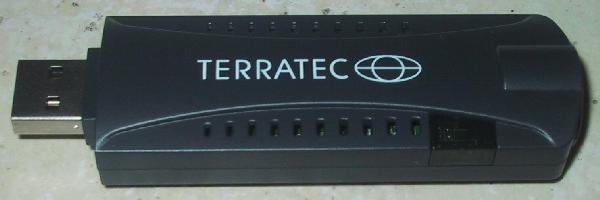
If you've made it here you probably already know what Software Defined Radio is: the use of processing power to supplant hardware in communications systems.
It comes in many techniques and flavours, but the most common is that of an (often minimal, but sometimes complex) RF hardware front-end which presents an I-Q pair of 'zero-IF' signals which are then processed into a recognizable recovered baseband signal by a powerful lump of code on a powerful lump of processing hardware. Often this is a program on a PC.
Welcome to the fun little world of RTL-SDR.
Now, I've been playing with SDR for some time; not only does my day-job take me down similar dark and dangerous twisty alleyways, but a high-end Flex and an SDR-IQ (truly excellent for purpose) have long supplanted conventional superhet radios at home. So interest was decidedly piqued hearing how little plastic USB dongles designed for off-air digital TV and DAB (Digital Audio Broadcasting) elsewhere than the US can be used as SDR front-ends - not the least surprisingly because that is exactly what they are!
In the dongle are two main chips - a tuner chip, and a high-speed A/D (Analogue to Digital) converter and USB interface. Incidentally, the 'RTL' in RTL-SDR comes from the part number of a popular converter/USB framing chip, the RTL2832U. Inside the tuner chip, essentially, is a broadband front-end programmable gain-stage, and a pair of multipliers (mixers) fed by the I and Q outputs (In-phase and Quadrature) of a wide-range programmable oscillator. The mixer outputs are then sent to the converter/framer. Such is the power of markets and technology that these things retail for around $20. Depending on the tuner chip, the frequency range is roughly between 50 to 2000MHz, some higher, some lower, but in those general realms. Impressive, huh? Now, these aren't exactly NASA-grade; I'm sure the oscillators are noisy, the front-end's noise factors not thrilling, and the converters are but a whopping eight bits deep. But for $20, who cares?
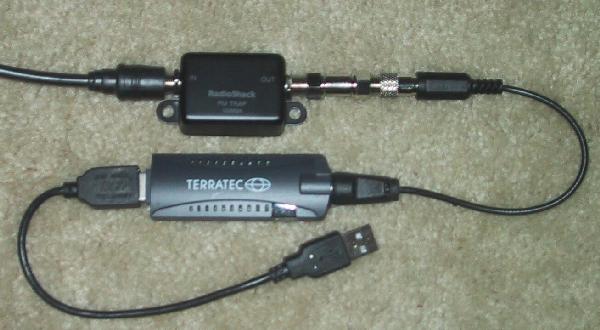
The other part of the receiver is of course the processing software residing on a 'puter. Fortunately there are several very good and very well priced (free, to really not much) SDR programs. The 'Install' package for one in particular comes ready with the driver the 'puter needs to recognize the RTL-SDR dongle, and is ready to run with it no messing about. This makes it a very good place to start, since the learning-curve and accompanying frustrations are minimized. It is called SDRSharp (or SDR#) because it was written in Microsoft's C# language.
Where do I get this stuff from?
Dongle
The dongles are readily found on e-bay. At the grave risk of this becoming out-of-date ridiculously quickly, I got mine from a dealer who somewhat specializes in them:
He has an e-bay 'storefront' and a web-page. I'm sure there are plenty of others but make absolutely sure that the type of dongle you order has been tried and is known to work in this application; this is why going to a 'specialist' dealer such as nooelec is a good idea. Buy the dongle with accessories (antenna etc.). These dongles are designed for use elsewhere other than the US and use 'funny' antenna connectors (mine has a 'Belling Lee', common in Europe) and you might well need the antenna lead at least to hack to make an adaptor.
Software - SDRsharp.com
Hunt aroung and find the SDR_install.zip. This contains everything you need in the way of program and drivers.
Installation
A good installation guide can be found at: rtlsdr.org
Using SDRsharp
If you've not used an SDR before it can seem intimidating. Just remember you can't hurt anything! Firstly, play with the tuning: clicking on the upper half of a frequency digit increments it, on the lower half it decrements. A red line on the spectrum display reflects the presently tuned frequency; a second red line follows the mouse, and clicking the mouse instantly moves the receive frequency to its position. Easy, eh? The mouse' scroll wheel tunes up or down in step-sizes selected by one of the little drop-down boxes on the left-hand side.
FM Radio
It's probably easiest to start tuning around where there are some known big signals, so select FM Wide, dial up somewhere between 88 and 108MHz, set the tuning rate to 100kHz, and tune around. Within seconds you should playing like a pro. Play around this easy park for a while to get used to what-does-what in the program.
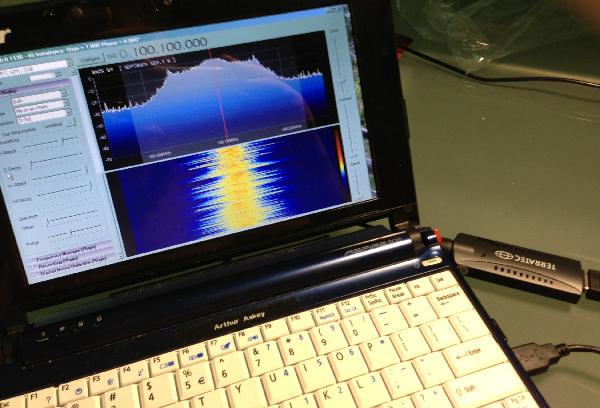
The setup a few minutes after installation, tuned to WQIC, a local FM station. The display bandwidth is 'zoomed in' to focus on that station, and the 'Decay' of the spectrum display cranked up such that it builds a long-term view.
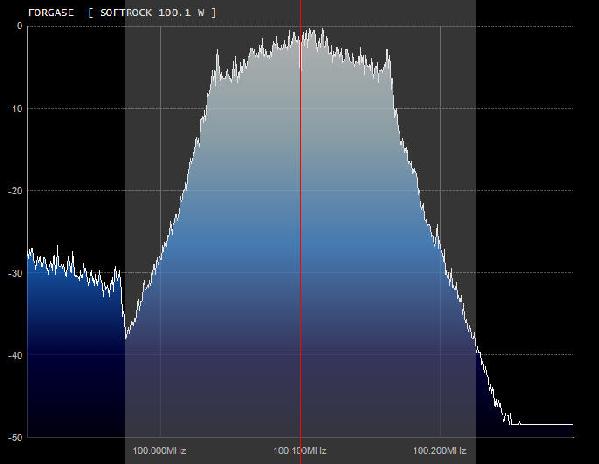
A better screen-shot. The RDS decode is a nice touch. It's easy to see the occupied bandwidth and the accumulated energy-vs-deviation shape says a lot about the modulation; in fact it's even possible to make an educated guess as to what airchain processor they're using! (Old. And likely beige.) The funny thing is that at the 'salt-mine' we have a gospel box the primary use for which is precisely this sort of analysis! $12,980 rebate, please?
Antennas Maketh The Man.
(Or woman.) The silly little antenna that comes with the dongle is dismal. It is resonant somewhere up in the gods (fine if you're looking for gods I suppose) but forces itself to be close to the receiver - i.e. indoors - and so entombed within the massive jumble of interference generators that is a typical household. If this is your sole exposure to the RTL-SDR you will be righteously disgusted; it'll seem like the receiver is deaf and shallow (no dynamic range) and struggles even getting the bigger FM stations - forget anything else. I cut the antenna feeder to make an adapter lead (Belling-Lee to 'F') and put a complementary 'F' on the antenna itself. And promptly put it in a box where it will be permanently forgotten. Fortunately I have a VHF/UHF discone on the roof.
What a difference!
I've never really been a scanner guy, but it was ridiculous fun exploring with this thing! Marine, aero, utilities, taxis, baby monitors, hambones, radio station studio-transmitter links - you name it. The spectrum display shows when nearby (within 1MHz) carriers pop up, so you get to play whack-a-mole with the cursor to see what they are. The aero frequencies (108-136MHz) are really good practice for this, since aero communications tend to be terse, cryptic and short.
Intermodulation, Fundamental Overload, and what to do about it.
That FM broadcast stations are such huge signals is a two-edged sword: It permitted us to hear *something* when we first turned on the RTL-SDR, but with a decent antenna attached locals can overload the tuner front-end. The effect can be somewhere between a forest of signals on the screen you simply KNOW aren't real, through funny noises and apparent lack of sensitivity, to the receiver simply blocking - stunned by the mere weight of RF into silence.
RF Gain
For immediate response, there is an RF gain control for the tuner; it's on a slidey-control in the drop-down box from 'Configure' above the spectrum display. This will be a an object-lesson in how a receiver acts as it comes out of fundamental overload! The downside is that you've just made the receiver that much less sensitive - this is the practical limitation of a receiver with a broadband front-end and limited (8-bit) dynamic range.
Notch Filters
Secondly, applying an olde-tyme bit of engineering, a filter ahead of the dongle to reduce the level of the FM stations will allow you to bring back up the receiver sensitivity without being hammered so badly. Trusty Radio Shack sell just such a thing: 'TRAMPA FM' (I kid not) Part Number 150-0024 . The RS box digs a big hole in the middle of the band (98MHz or so) but is a bit sloppy (the fond notion that everything else is unaffected whilst the FM band is zorched completely is just that, fond) but it does help. It's designed to aid off-air TV receivers creamed by FM overload, which is sort-of what we're trying to achieve, too. It's cheap enough just to try. It might well allow you to turn the RF Gain back up to better hear other stuff.
Alternatively, or if the RS filter just doesn't cut it, Captain Altoids can ride to the rescue if you're good at winding a few turns 'round a pencil and have to hand (or can readily source) the appropriate value capacitors. A filter set made out of a bridged-tee or two, or three, with the notches tuned directly to the worst offenders would be better both in attenuation and less effect out-of-band, but labour intensive and fiddly to tune - although using the RTL-SDR itself as test gear would go a long way!
FM signals are not the only blazingly strong signals with which the RTL-SDR may have to contend. Although it's easy to forget about the systems because they're so ingrained into our existence, cell-phones - both the handsets and the towers - can easily crush a broadband front-end. It's worth a spin through 700 - 1200 MHz to find what these things sound like so it's easy to recognize them if they turn into a problem. Another potential source is TV; these again are huge. It used to be easy to suss these by ear (the line and frame frequencies were plain) but since the switch to digital they, like any good advanced modulation scheme, are just big, wide lumps of white-ish noise. This can be perplexing since it tends to confuse cause-and-effect - it might seem like the receiver's simply going deaf, hearing nothing but hiss, whilst in fact it could just be being de-sensed by Fox News.
At the higher frequencies of TV and cell-phones, another - simple - filtering scheme becomes practical: The tuned coax stub. This is an open quarter-wave length of coax connected across the antenna feeder (an 'F' T-connector is the neatest solution), cut to the offending frequency. It has the huge benefits of simplicity and at the higher frequencies, size. They're short little pigtails. Although in principle it would work for FM too, there are two issues which may or may not be a bother to you: At FM the stub will be around 2 feet long (60cm) or so; It also notches at every odd harmonic above its base frequency, i.e. around 300, 500, 700, 900MHz et-spectral-cetera.
Self-Inflicted Wounds
It may be that you hear little, see wall to wall large noise on the spectrum display, and can only resolve the very biggest of signals. Chances are the receiver is hearing interferences generated close at hand. Obviously, a remote antenna should help this by both receiving more desired signal whilst being further away from the interferences but the interferers continue to exist. The biggest evil is switch-mode power supplies. Laptop power supplies, especially the cheap third-party replacements for the original one you lost(!) are The Worst. Unplugging mine from the 'puter itself helps a bit, but it has to unplugged entirely from the wall before the racket stops. And that's just ONE supply, albeit close to RTL-SDR home, but nonetheless - one.
Computer requirements
From the pictures you can see that SDRsharp runs on an old, battered and beloved early-Atom-powered netbook - hardly a speed demon. Yes, it runs - just. Note that I've turned off the waterfall display, and not-so-noticably I 'ride' the resolution of the power-hungry spectrum display FFT's resolution (lower resolution, less power). Nothing else is running on the machine! All that said, it is a low power machine and any sensible modern 'puter will have no problem whatsoever. Just don't try to run computationally intense programs such as these on the hand-me-down clunker in the den.
SDRsharp as mentioned earlier is written entirely in C#, a high-level language. "So's everything else!" you protest. Yes, but many other PC based DSP programs use optimised machine-code elements where it counts, such as computationally intensive filters and FFTs; this makes them overall more efficient. 'WINRAD', for example, is about half the runtime of SDRsharp, if this is important to you.
Don't get me wrong: I don't have it in for SDRsharp; it is a solid competent piece of software that does what it says on the tin, and allows one to wake up the dongle from cold and play radio within minutes. It deserves full props. For getting one's feet wet and figuring out what one really wants in a program, it's a winner.
Other SDR programs have more features and are a bit more 'radio-person' friendly; in particular, memories make operating an RTL-SDR so much easier. Tuning mechanisms are different and sometimes more intuitive, and most have separate 'RF side' spectrum displays and 'Demodulated side' displays; from a programming perspective this is more efficient, since it can afford using more relaxed FFTs to be used on each. The 'one display' method means for really high resolutions (typical of QRSS etc.) that the one FFT has to become quite heroically large, and, operationally the very fine resolution needed for some modes or analysis is at odds with that needed for tuning.
Using the RTL-SDR on HF (below 30MHz)
With a lower frequency limit of somewhere south of 100MHz the RTL-SDR needs a frequency converter to listen to HF (0-30MHz). These frequency-translate the 0-30MHz band up to within the operating bandwidth of the RTL-SDR. For instance, a 100MHz-based convertor would make the HF band accessible between 100 and 130MHz. Such are easy to build (Altoids tin, anybody?) and inexpensive kits are available ( nooelec again, for starters).
(It should perhaps be noted that 100MHz isn't a particularly good choice for an IF base, since it is begging for IF breakthrough from FM broadcasters - almost anywhere else is preferable! I believe the nooelec unit is 120 or 125MHz, whilst 144MHz is common for amateur radio historical reasons - see below)
I suddenly realized I had an upconverter already, lurking in a box from another project long ago. It's a Datong UC-1, and dates from the era where UK 'Class B' licencees who were ghettoed on 2m and up needed a way to listen on the HF bands without buying a full HF rig. The conversion was in 1MHz chunks up to 144-145MHz; the two dials on the left are safe-cracker specials, dialling in the 'chunk'; the rightmost knob an input attenuator; the two middle knobs are the range and tuning for the front-end preselector.
Bingo!
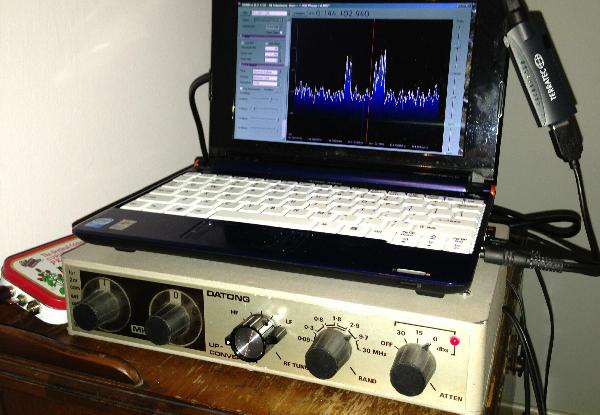
Upconversion is not an ideal architecture for a high-performance receiver - the frequency accuracy and stability are subject to the combined qualities (or otherwise) of the upconversion oscillator and the SDR oscillator; likewise the oscillator noises are rarely the tops, and are exacerbated by the increased frequency. Oscillator noise isn't much of a problem while decoding wideband, or even narrowband, FM, but shows up on SSB and particularly CW; QRSS decodes become a fuzzy wash. The limitations of a 8-bit A/D conversion show up as expected in limited dynamic range - but with a tuned preselector as in the Datong, only the frequency range of interest receive gain and out-of-band signals are attenuated, so becoming less able to create intermodulations. It is with a wry chuckle I remind you that this is *exactly* the technique which made many old valve (tube) and early solid-state radios even half-way useful; for the most part their innate dynamic ranges were dire; it was only front-end selectivity that saved them.
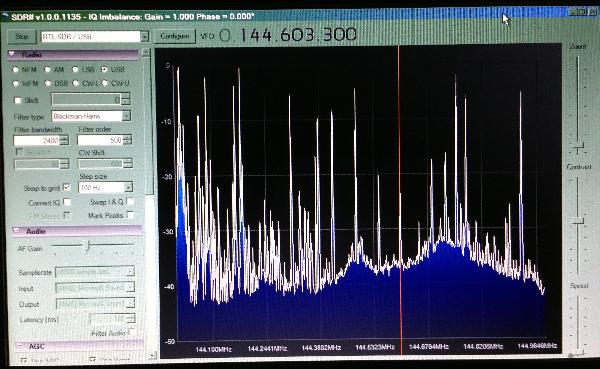
Sensitivity and its handmaiden noise-floor so far haven't been explored too deeply; on HF almost everywhere I listened I could hear sky noise, which is kind-of saying sensitivity is 'adequate'.
Ah. Yes. I can only use the system when my laptop power supply is not only unplugged from the 'puter, but from the wall. It is THAT noisy that it renders HF reception worthless. Now, a combination of factors are in play here, but the basic lesson remains. The little Altoids tin to the left of the upconverter is the power inserter / battery box / filter set / controller for the e-probe antenna being used. E-probes can be extraordinarily good performers but have the niggling problem that unless the feedline is seriously decoupled by grounding and filtering the feedline remains an active part of the antenna. (See Reducing Noise on Receive Antennas) The upshot is that everything connected to that feedline becomes part of the antenna. Well, being a lash-up (it's my throw-it-in-the-back-of-the-car e-probe-on-a-fishing-rod) of course the feedline isn't decoupled... every tiny piece of noise on the AC power ground connects straight to the antenna. Even unplugged from the 'puter, the supply made so much racket and being still within a few feet of the 'antenna' - unplugging it entirely was the only way of shutting it up. Oh, and then there was the switching supply for the bedside table lamp, and the cell-phone charger, and the...
I have used *far worse* receivers on HF than this upconverter/RTL-SDR combination. It wouldn't be my first choice on the bottom end of 20m during the CQ WorldWide Contest, but it's downright usable and more than a toy.
RTL-SDR - What it is, and what it isn't
The RTL-SDR dongle in combination with the definitely-recommended-for-starters SDRsharp SDR program make a surprisingly competent and usable non-scanning VHF-UHF receiver. Other SDR programs offer more and useful features. The common pre-perception that it will be insensitive and the limited dynamic range render it useless prove completely unfounded, given a good antenna and maybe an FM trap.
It is not a world-beater. It is comparable in performance to popular handheld scanners.
That said, no other way will you be able to get a versatile VHF-UHF receiver, or so much fun, for around $20. Do it!
Don't be disheartened by reading this all the stuff in this article and think all you're going to get are problems; too hard basket. Far from it - most just run these things bareback with nary an issue. I'm an engineer and just can't leave well enough alone, but this may help you figure strangenesses out.
© Steve Dove, W3EEE, 2013